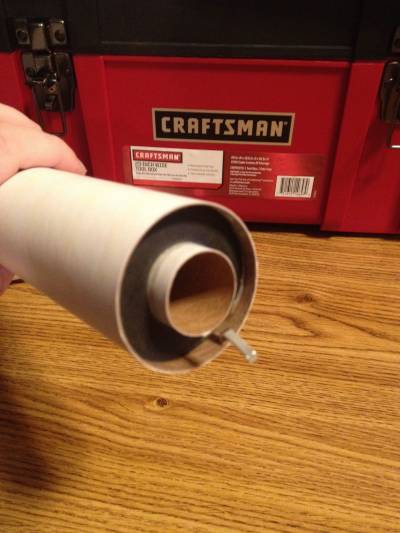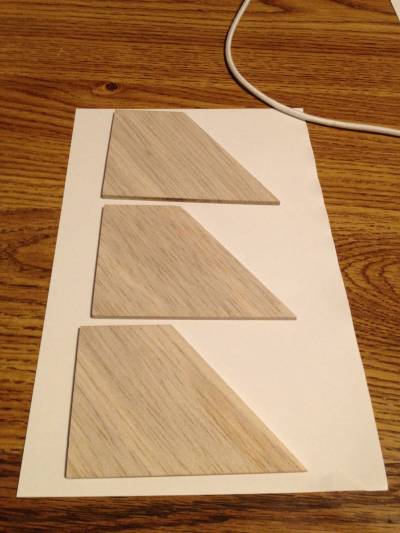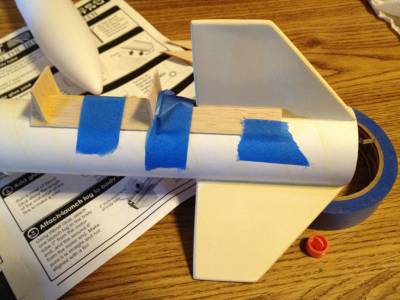Mean Green
By Robert Belknap
2011-11-06
I picked this up from the on-site shop during my son's last Cub Scout Rocket Jamboree. It's a pretty simple kit, but I wanted to take my time building it and documenting the process. My goal was to really pay attention to the final finish of the rocket. I've been reading several other build logs, and I picked up more than a couple of tricks I wanted to try out.
Prepping the Body Tube
2011-11-06
I had some time to start this kit today. The first step: filling the seams on the body tube with wood filler. I thinned the filler out with water, then I painted it on along the seams of the body tube. After letting it dry, I sanded off the (considerable) excess. I really glommed the filler on this time. My mixture was too thick at first, and I was in a bit of a hurry. I knew it would add to the amount of sanding I'd have to do later, but I was racing the "boys-are-napping" clock. 


It seems like a lot of work for such a small detail, but filling the seams really helps improve the finish of the rocket.
Once the sanding was complete, I ran a bead of CA around the inside of what will become the front of the body tube. (This will re-enforce the BT and help prevent against zippering.)
Motor Mount Assembly
2012-02-15
The holiday season got busy. It's been almost 3 months since I did any work on this rocket. I pulled the kit and my building supplies out while the boys were asleep and got to work. (Noticing a theme here? Maybe I should call this Rocket "The Big Sleep")
I started out by test-fitting the nose-cone into the body tube. It was a bit tight, so I sanded the shoulder as well as the CA glue inside the tube. I noticed the blow-molded plastic at the corners on the nose-cone shoulder is a bit thin. It shouldn't affect the rocket too much, but I should probably re-enforce it a bit. (Looks like a job for some shapelock.)

Once the nose and body were taken care of, I moved on to the shock cord and motor mount assembly. The instructions are pretty straight forward. I did cut a small notch in the upper centering ring in order to make it easier to get the kevlar through.

While the motor mount assembly was drying, I began working on the fins. I sanded of them lightly while they were still attached to the balsa sheet, then I carefully detatched them. (This is about the time the boys woke up, so I took a break.)


After the motor mount was completely dry, it was time to glue it into the body. I had to sand the centering rings slightly in order to get the assembly into the body. Once that was done, it seemed like a good time to attach the elastic shock cord and parachute to the nose. Then I got to work on prepping the fins...


Fin Preparation
2012-02-15
I wanted to lminate the fins with paper. I did this on the first batrock I built and I like the technique for adding strength to the fins. I probably don't need it as much on this rocket, but it also helps with the finish.
I started out by sanding the edges until everything was smooth.

I took some thinned out wood glue and brushed it on the fins before laying them out on a sheet of paper. Then I applied glue to the other side, added another sheet. This went bewteen a layer of wax paper and then weight was applied to keep the fins from warping while the glue dried. (in the form of an un-abridged dictionary and a large cook book.)


(Note To Self: When laying down the fins, make sure to work any air bubles out, or you'll be pulling the laminate off and sanding the fin down to do it again...)

I let the glue dry over night (after re-laminating one fin...) Then trimmed the paper with a sharp hobby knife. One more quick sanding to deal with paper chaff, and the fins are ready for the next step.

Fin Preparation II : The Attachment
2012-02-20
The next step was rounding the all the edges of the fins, except the root. Then it was time to mix another batch of wood filler. (I suppose I could have started with the fin prep at the very beginning of the build, and then filled them the same time I did the body tube.)



I tried a new technique (I read about on EMRR) to mask the root edge while applying the wood filler to the fins. I let the fins dry over night, and then sanded them smooth. (320 grit sanding fim, followed by 400 grit, and then 600 grit.)

With the fins complete, it was time to attach them to the body tube. Pretty standard technique here: double-glue joint as described in the build instructions followed up with glue fillets. The alignment on my second fin was a little off, so I removed it and tried again. Then I realized I attached it backwards. (d'oh) Third time was a charm.




Once all the fins were attached, I added the launch lugs. I unwrapped the fin alignment guide, added a line midway between 2 of the fins, re-taped and slid the ring back on the body tube. I used the new line to mark where I wanted the launch lugs to be attached.

I can never get these on without air-bubles in the re-enfocing glue fillets, so I'm trying something new and filling the holes with a bit of wood filler once the fillets dry.
All that's left is to paint and apply decals.
Painting
2012-02-28
I got some time (and good weather) this weekend to begin painting. (Grandparents took the boys off on adventure.)
Nothing special here. I did find a tip somewhere about using old DVD spindles as stands for rockets with engine hooks. I beefed up the spindle size with some masking tape, then slipped a couple of tubes from my old estes fin jig on the end to make a stable mounting point.
I'm going with the stock paint scheme for this bird. I'm using Model Master Enamel in Sublime Green (2967) and Classic Black (2911)
It would have been easier to paint the base of the rocket if I had mounted it on a dowel, or something, but this worked out well enough.
1st coat of primer:

Sanding and then 2nd coat of primer:

Now for the base color...
1st coat:

2nd coat:

3rd coat:

Letting it sit for a couple of days before masking and applying the contrasting color:

(That's an Estes Blue Ninja my son put together last saturday - with a bit of help)
Finishing Touches
2012-03-01
So, today I finished off my Mean Green kit.
First, I used scotch tape to mask off the area to be painted black. I've read here (more than once) that this is the best way to get a clean line. I figured that I'm going to have the decals over-lap the transition point between the colors, so if something goes wrong, no big deal. I can see how it works with future projects in mind.
Once the scotch tape was down, I covered the rest of the rocket with paper (and a plastic bag,) then hit it with an initial coat of black.

A second coat of black was needed to get good coverage. Once that was done, I let it dry for a few hours and then carefully pulled the mask off. Wow, that has got to be the cleanest line I've ever managed to paint! I was in such a rush to get the decals on, I forgot to take a picture.


After trimming and applying the decals, I decided that the leading edges of the fins needed to be black as well, so I pulled out a brush and one of those small pots of testors enamel to finish the paintjob.


MUCH better. 
(I didn't plan this, but I like how the CD spindle base is now painted to match the rocket.)
Sponsored Ads
 |
 |















